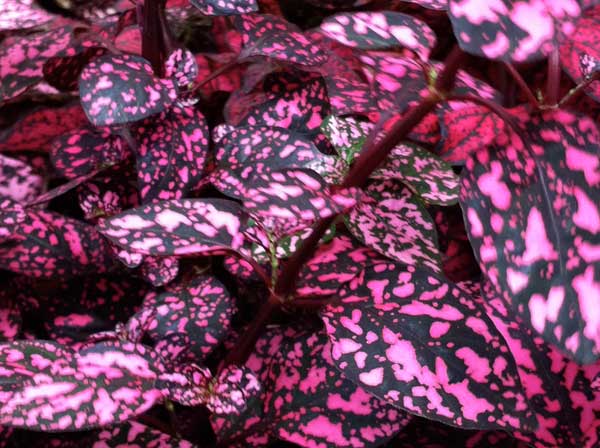Hypoestes Phyllostachya: Unveiling the Beauty of the Polka Dot Plant
Hypoestes Phyllostachya, commonly known as the Polka Dot Plant, is a captivating evergreen shrub that belongs to the Acanthaceae family. Native to South Africa, Madagascar, and Southeast Asia, this delightful plant is cherished for its unique spotted leaves, which come in various shades of white or pink, creating a visually stunning display.
Distinctive Features and Enchanting Charm:
Spotted Foliage: The Polka Dot Plant showcases opposite leaves adorned with eye-catching spots. These charming spots are lighter on the back of the leaves compared to the front, adding depth and character to the foliage. The striking contrast between the spots and the base color of the leaves is a defining feature of this plant.
Small Flowers on Spikes: While the Hypoestes Phyllostachya‘s main attraction lies in its vibrant leaves, it also produces small, delicate flowers in shades of pink or purplish hues. These flowers appear on spikes and add a subtle touch of elegance to the overall appearance of the plant. However, it’s the foliage that steals the show.
Cultivation Tips for Hypoestes Phyllostachya:
Light and Moisture Requirements: To maintain the Polka Dot Plant’s colorful and captivating foliage, it requires bright, indirect light. Avoid exposing it to direct sunlight, as it may cause leaf burn. Similar to other tropical plants, the Polka Dot Plant appreciates humidity and moist conditions. Regular watering is necessary to keep the soil evenly moist, but be cautious not to overwater and allow the plant to sit in soggy soil, as it can lead to yellowing leaves.
Ideal Growing Conditions: In warmer climates or tropical regions, Hypoestes Phyllostachya can be grown outdoors. However, in cooler climates, it is often cultivated as a container plant indoors. The plant reaches a height of approximately 10 to 50cm (4 to 20 inches), making it a versatile choice for various settings.
Pinching for Bushiness: Pinching the new growth of the Polka Dot Plant can encourage bushier growth, enhancing its overall appearance. This practice helps maintain a compact and lush form, creating a more appealing display.
Propagation Possibilities: Propagating Hypoestes Phyllostachya can be achieved through seeds or cuttings during the spring or summer. By following appropriate techniques, you can expand your collection of these charming plants and share their beauty with others.
Maintenance Considerations:
The Polka Dot Plant is generally pest-free; however, it is important to remain vigilant for signs of mildew, which can occasionally affect its foliage. Providing proper air circulation and avoiding excessive moisture on the leaves can help prevent such issues.
By incorporating Hypoestes Phyllostachya into your indoor or outdoor spaces, you invite the captivating beauty of the Polka Dot Plant into your surroundings. With its stunning spotted leaves, delicate flowers, and unique appearance, this plant is sure to captivate the hearts of plant enthusiasts and bring a touch of whimsy to any setting.





